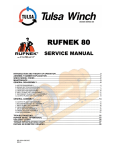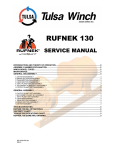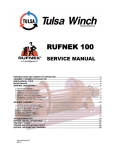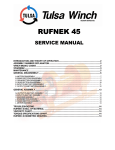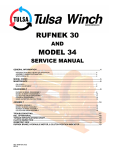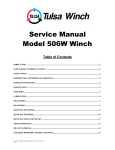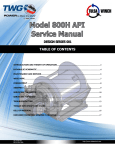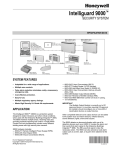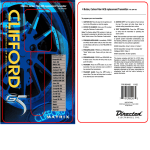Download RN80P Service Manual
Transcript
DESIGN SERIES 004 RUFNEK 80 SERVICE MANUAL INTRODUCTION AND THEORY OF OPERATION ..................................................................................... 2 ASSEMBLY NUMBER EXPLANATION ...................................................................................................... 2 WINCH MODEL CODES .............................................................................................................................. 2 MAINTENANCE............................................................................................................................................ 5 GENERAL DISASSEMBLY.......................................................................................................................... 6 A. MOTOR DISASSEMBLY................................................................................................................................................................6 B. BRAKE SECTION DISASSEMBLY ................................................................................................................................................7 C. DRUM SECTION DISASSEMBLY .................................................................................................................................................8 D. GEAR SECTION DISASSEMBLY................................................................................................................................................10 E. INPUT PLANET SET DISASSEMBLY..........................................................................................................................................11 F. SECONDARY PLANET SET DISASSEMBLY..............................................................................................................................12 G. OUTPUT PLANET SET DISASSEMBLY .....................................................................................................................................12 GENERAL ASSEMBLY.............................................................................................................................. 12 H. OUTPUT PLANET SET ASSEMBLY ...........................................................................................................................................12 I. SECONDARY PLANET SET ASSEMBLY .....................................................................................................................................12 J. INPUT PLANET SET ASSEMBLY ................................................................................................................................................12 K. GEAR END ASSEMBLY ..............................................................................................................................................................12 L. DRUM SECTION ASSEMBLY......................................................................................................................................................12 M. BRAKE SECTION ASSEMBLY ...................................................................................................................................................12 N. MOTOR ASSEMBLY ...................................................................................................................................................................12 TROUBLESHOOTING................................................................................................................................ 12 RUFNEK 80 BILL OF MATERIAL ............................................................................................................. 12 VISCOSITY CHART ................................................................................................................................... 12 TORQUE SPECIFICATIONS CHART........................................................................................................ 12 RUFNEK 80 ISOMETRIC DRAWING ........................................................................................................ 12 SEL-0041-004.DOC REV-0 INTRODUCTION AND THEORY OF OPERATION The Rufnek series planetary winch is designed to use a high-speed gear motor, driving through a multiple disc brake, through three planet sets to the cable drum. The multiple-disc brake is spring applied and hydraulically released through a port in the brake housing. During inhaul, the brake is not released since the load is driven through the one-way cam clutch, bypassing the brake. When the load comes to a stop, the cam clutch locks up and the load is prevented from moving by the brake. The brake and brake valve receives its signal any time the winch is in pay out. With the brake fully open at about 340 PSI the brake valve will open and dynamically control the lowering of the load. ASSEMBLY NUMBER EXPLANATION This manual is for design series 004. In the case of a major design change implementation, a new design series designation number will be issued for the winch. A new manual will also be created for that specific design series. DESIGN SERIES ASSEMBLY # 82021 004 WINCH MODEL CODES RN80 P H L X O A 1 Motor Type 1. Single Speed Gear Motor 2. Two Speed Gear Motor 3. Single Speed Geroler Motor 4. Two Speed Geroler Motor 5. Piston 6. Vane X. No Motor Gear Type W=Worm P=Planetary Drive Type H=Hydraulic M=Mechanical Gearbox Position L=Left R=Right (viewed from rear of truck) Input Shaft Location F=Front R=Rear X=Does not apply (viewed from rear of truck) Clutch Device M=Mechanical A=Air Cable Spooling O=Over Drum U=Under Drum (viewed from rear of truck) 2 FAILURE TO HEED THE FOLLOWING WARNINGS MAY RESULT IN SERIOUS INJURY OR DEATH. The safety of the winch operator and ground personnel should always be of great concern, and all necessary precautions to insure their safety must be taken. The primary mover and the winch must be operated with care and concern for the equipment and the environment and with a thorough knowledge of the equipment and its performance capabilities must be understood. These general safety guidelines are offered, however local rules and regulations or national standards may also apply. Recommended references are, but not limited to, ANSI B30, OSHA 1910, AWS D 14.3, and SAE J706. Additional information can be found at http://www.team-twg.com/TulsaWinch/ Indicates an imminently hazardous situation which, if not avoided, will result in death or serious injury. Indicates a potentially hazardous situation which, if not avoided, could result in death or serious injury. Indicates a potentially hazardous situation which, if not avoided, may result in minor or moderate injury or property damage. Mounting: Indicates information or a company policy that relates directly or indirectly to the safety of personnel or protection of property. Winch mounting must be secure and able to withstand the applied loads. • • • • The stability of the mounting system must be approved by a qualified person. All welding should also be done by a qualified person. Winch mount must be flat so as not to induce binding. The flatness must not exceed 1/16 inch across the mounting surface of the winch itself. Insure that all hydraulic hoses, valves and fittings are rated to winch manufacturer’s operating pressures. Relief valves should be set to winch manufacturer’s specifications. 3 Operator: Must read and understand the operating and service manual. Both the SERVICE MANUAL and OPERATING AND MAINTENANCE MANUAL are available online at http://www.team-twg.com/TulsaWinch/ Must never lift or move people with this winch. This winch is not designed or intended for any use that involves moving people. Must stay clear of the load at all times. Ground personnel should remain a safe distance from the load and winch cable at least 1 ½ times the length of cable measured from the winch to the load. Must stay clear of the cable at all times. A broken cable can cause serious injury or death. Must avoid shock loads. Shock loads can impose a strain on the winch that can be many times the design rating. Must be aware of the fleet angle of the winch. All loads should only be pulled with the load line perpendicular to the drum shaft, this is to avoid excessive stresses on the winch and will help prevent the cable from building on one side of the drum flange. Must wear personnel protective equipment (PPE) if required. Check the local, state and federal regulations for compliance. Must insure that the drum clutch is fully engaged before hoisting. A visual inspection of the drum clutch engagement is required before each winching operation. Must rig all loads secure before winching. Pull the load line taut and inspect the condition of load for stability. Must inspect the drum brake if equipped. The drum brake is not a load holding device it is design to prevent over spooling of the drum and causing bird nesting of the cable on the drum. Inspect the brake for wear of the lining and the actuation method. Must inspect the load control brake. These winches are equipped with two (2) forms of dynamic braking. The springapplied/hydraulically-released multi-disc oil brake is one method. Before a load is handled the load should be pulled tight and stopped to check this brake. The second method is a hydraulic lowering control. The same method should be used to check this brake. Operation: • • • • • All winch controls must be well marked for function to avoid confusion. All winch controls must be located to provide the operator with a clear view of the load. The clutch must be inspected daily for proper operation. The winch cable should be inspected daily for serviceability. A minimum of five wraps of tightly wound cable must remain on the drum. 4 MAINTENANCE Tulsa Rufnek series planetary winches, like any other piece of machinery, need to be periodically serviced and well maintained to insure proper operation. Good maintenance consists of four steps. 1. A daily inspection to insure that there are no oil leaks present and that all mounting bolts and other fasteners are tight, and that the wire rope is in good condition. 2. Changing the oil in both the gearbox and the brake section. (Severity of use will determine the need for oil changes but it should be checked at a minimum of every 500 hours. Factors such as extremely dirty conditions or widely varying temperature changes may dictate even more frequent servicing). 3. Lubing drum bushings and sliding clutch with grease thru grease fittings located on drum barrel and clutch. 4. Complete teardowns and component inspections. (Again, severity and frequency of use will determine how often this should be done). If the equipment that this winch is mounted to is subject to standards for this type of inspection, then those standards must be followed. If oil changes reveal significant metallic particles then a teardown and inspection must be made to determine the source of wear. Rufnek series planetary winches are designed with a common oil reservoir for the gearbox and brake. The winches are shipped from the factory filled with Mobilube SHC SAE 75W-90 synthetic gear oil which is satisfactory for operation in ambient temperatures from -40°F to +110°F. If winch will be operated in temperatures outside this range, contact Tulsa Winch for recommendations. The oil is drained by removing the drain plugs (85 & 81) located at bottom of adapter cover (58) and bottom of brake cover (2). Then remove the fill plugs (74 & 81) located at the top of the gear housing (60) and the top of the brake cover (2). Inspect the oil for signs of metallic particles and/or burning and dispose of in a proper manner. Then reinstall the drain plugs. Fill the brake end with Mobilube SHC SAE 75W-90 (1/2 quart), then fill the gear end with Mobilube SHC SAE 75W-90 oil (9 quarts) and replace both of the fill plugs. OIL CAPACITIES = 9.5 QUARTS 5 GENERAL DISASSEMBLY A. MOTOR DISASSEMBLY 5. Remove the counterbalance valve (108) from the counterbalance block (76) and inspect the metering hole to make sure it is not obstructed. Also, inspect the o-rings on valve to insure that they are not flat or cut. Replace if necessary. 1. Drain the oil from the brake assembly by removing the plug (81) from the bottom of the brake cover (2). 2. Remove hoses (4, 54, 56, 77, & 80). 3. Remove the counterbalance block (76) and the manifold block (93), from the motor by removing the four cap screws (106). 6. Motors and counterbalance valves are not serviceable in the field. Return them to an authorized dealer for service. 4. Remove the motor from the winch by removing four capscrews (88). 7. Inspect o-rings (98) & (107) for damage. 6 B. BRAKE SECTION DISASSEMBLY the piston and polish if needed. Friction discs should measure no less than .055-in. thickness and stator plates should measure no less than .068-in thickness. 1. Evenly remove the four cap screws (3) that hold the brake cover (2) in place. Spring pressure will raise the cover up as the cap screws are loosened. Carefully remove the cover (2) from the brake housing (20). Inspect the o-ring (6) on cover for damage. 6. To disassemble the brake driver/clutch assembly, remove the retaining ring (17) from either end of the driver. Then, remove the brake driver (14) and bearing (15) from the input driver (19). Next, remove the sprag clutch (18). Finally, remove the retaining ring (17) from the other end of the driver, then remove the second bearing (52) from the input driver. 2. Remove the springs (7) from the piston (5) and check the free height. Each spring should measure at least 1.240 inches with no force on them. 3. Remove the piston (5) by installing two pieces of 3/8”-16NC all thread into the two holes in the top of the piston and run in evenly until the piston is clear of the housing. An alternate way of removing the piston is to use shop air to slowly pressurize the brake cavity to remove the piston from the brake housing (20). Notice the direction of lock-up on the clutch for re-assembly. Inspect the input driver and brake driver for wear, replace if necessary. 4. Inspect the o-rings (8, 10) and back up rings (9, 11) on the piston, replace if necessary. Grasp the brake driver/clutch assembly (assembled items 14, 15, 17, 18, 19, 113) and remove it from the brake housing. 7. Remove the bearing housing (16) and inspect the bearing (52). 8. If the bushing or seal in the brake housing needs to be replaced, follow the drum section disassembly and reassembly sections of this manual prior to reassembly of the brake.. 5. Remove the stator plates (12) and friction discs (13) from the brake housing and check them for excessive wear. Replace the parts if necessary. Be sure to check the top stator plate for scoring caused by the removal of 7 C. DRUM SECTION DISASSEMBLY shaft (38). At this time you will need to remove the two cap screws (70), nuts and washers (71, 72) from the frames (64 or 65). You can now remove the brake band assembly (66). Note which frame the mounting bolts are on for re-assembly. Inspect and replace if needed. 1. To remove the drum, first disconnect the cable from the cable clamp (35) and lay aside. If removing the drum from the motor end with the motor and brake disassembled, first remove the cotter keys (100) and clevis pins (49) connecting the yoke (67) to the bracket (90) & air cylinder (105). Second, remove the eight cap screws (29 & 69), four spacers (97), air cylinder cover (91), air cylinder (105), and bracket (90). 3. Remove the outer thrust collar (53) by loosening the three set screws (50). 4. Remove the yoke (67), sliding clutch (27), and coupler (30). Remove the three keys (94) and the inner thrust collar (24). Remove the drum using a hoist. Inspect the bushings (31) in both ends of the drum. You may need to remove the air lines, so it’s a good idea to mark them for re-assembly. 2. Support the weight of the drum with a hoist. Remove the four cap screws (61) along with the nuts and washers (63, 62) on the bottom of the brake housing (20). Disconnect the airline running from the air cylinder (68) to the brake housing (20). Remove the brake housing by sliding the housing off the output You should also inspect the bushing and seal (21, 25) that are located in the end of the brake housing. 8 CLUTCH INSPECTION 9 D. GEAR SECTION DISASSEMBLY 1. Drain the oil by removing the plug (85) located on the bottom of the adapter cover (58). 6. Remove the sun gear (45) and secondary gear set (41). Inspect and replace if necessary. 2. To disassemble the gear section, remove the Intelliguard™ spacer (39) from the outer cover (55) by removing three capscrews (44). Inspect the gear teeth on the Intelliguard™ (39) for wear. The Intelliguard™ system is not serviceable in the field. Return to an authorized dealer for service. 7. Remove the primary housing (58) by removing eight capscrews (32). Inspect the o-ring (59) and replace if necessary. 8. Remove the spacer (28) and sun gear (46). Inspect for wear and replace if necessary. 9. Remove the snap ring (47) from the output shaft (38). 3. Remove the outer cover (55) by removing the ten capscrews (112). 10. Remove the output gear set (40) and thrust washer (37). Inspect and replace if necessary. 4. Inspect the o-rings (57 & 114) for wear and replace if necessary 5. Remove the input gear set (42) along with the inner and outer thrust washers (43) Inspect and replace if necessary. 10 E. INPUT PLANET SET DISASSEMBLY 1. Remove the retaining rings (6) from the carrier (1). 3. Remove the planet gears (4), thrust washers (3), and bearings (5) from the carrier. 2. Remove the planet pins from the carrier (1) by carefully tapping them out. 4. Inspect the parts for wear or damage and replace if necessary. 11 F. SECONDARY PLANET SET DISASSEMBLY 1. Remove the retaining rings (7) from the carrier (1). 3. Remove the planet gears (6), thrust washers (3), bearings (4), and spacers (5) from the carrier. 2. Remove the planet pins (2) from the carrier (1) by carefully tapping them out. 4. Inspect the parts for wear or damage and replace if necessary. 12 G. OUTPUT PLANET SET DISASSEMBLY 1. Remove the retaining rings (7) from the carrier. 3. Remove the planet gears (2), thrust washers (3), bearings (6), and spacers (5) from the carrier. 2. Remove the planet pins (4) from the carrier (1) by carefully tapping them out. 4. Inspect the parts for wear or damage and replace if necessary. 13 GENERAL ASSEMBLY H. OUTPUT PLANET SET ASSEMBLY 1. Insert the gears (2), bearings (6), spacers (5) and thrust washers (3) into the carrier (1). 2. Being careful to line up the thrust washers (3) and bearings (6) with the planet pins (4), press the pins into the carrier. 3. Replace the retaining rings (7). If the pins are not lined up properly, the thrust washer can be shattered during the pressing operation. 14 I. SECONDARY PLANET SET ASSEMBLY 1. Insert the gears (6), bearings (4), spacers (5), and thrust washers (3) into the carrier (1). 2. Being careful to line up the thrust washers (3) and bearings (4) with the planet pins (2), press the pins into the carrier. 3. Replace the retaining rings (7). If the pins are not lined up properly, the thrust washer can be shattered during the pressing operation. 15 J. INPUT PLANET SET ASSEMBLY 1. Insert the gears (4), bearings (5) and thrust washers (3) into the carrier (1). 2. Being careful to line up the thrust washers (3) and bearings (5) with the planet pins (2), press the pins into the carrier (1). 3. Replace the retaining rings (6). If the pins are not lined up properly, the thrust washer can be shattered during the pressing operation. 16 K. GEAR END ASSEMBLY 6. Install the secondary sun gear (45). 1. Bolt the gear-housing (60) loosely into both frames (64, 65). 7. Install the inner thrust washer (43) onto the input gear set (42). Insert the input gear set (42) into the ring gear (22) making sure it is against the thrust washer (43). Put the outer thrust washer (43) in place and slide the input shaft (39) through the sun gears and output shaft (38). Let the input shaft protrude out on the gear end so that all of the spline is showing. 2. When reassembling, apply grease to parts such as thrust washers, o-rings, and seals. Install the output shaft (38) into the gear housing (60). Slide the thrust washer (37) onto the output shaft (38). Next, install the output gear set (40). Then install the retaining ring (47) onto the output shaft (38). Push the gear set and shaft back into the housing until it stops against the thrust washer (37). 8. Put the cover (55) on and secure it with eight capscrews (3), being careful not to damage the o-ring (59). Install the Intelliguard™ sensor (39) into the cover (55) with three capscrews (44), again making sure not to damage the o-ring (114), add locktite and secure it with three capscrews. (44) Make sure to line up all three planet gears in the output gear set with the gear housing as it starts into the housing. 3. Install the sun gear (46) and spacer (28). Make sure the input shaft engages the gear in the Intelliguard™ correctly. 4. Install the primary housing (58) onto the gear housing (60) with eight capscrews (32), making sure not to damage the o-ring (59), and torque them to specification (see page 27 of this manual). 5. Install the secondary gear set (41). . Make sure to line up all three planet gears in the secondary gear set with the gear housing and sun gear as it starts into the housing 17 L. DRUM SECTION ASSEMBLY (34) and the brake band (66). Then, tighten the jam nut to secure the adjusting nut. 1. After inspecting and replacing the necessary parts, such as the drum bushings (31). Install the drum (34) onto the output shaft (38). This part is very heavy and you will need the assistance of a hoist. With the weight of the drum supported, install the brake band assembly (66) along with the bracket (73), capscrews (70), nuts (71), and washers (72). 3. Install the inner thrust collar (24) making sure the half-moon slots are lined up with the key slots in the output shaft (38). Tap the three keys (94) into their slots in the output shaft. 4. Align the coupler (30) with the keys (94) and slide it onto the output shaft (38). Install the sliding clutch (27) and yoke (67) onto the coupler (30). You may need to lower the drum to align the holes in the brake band with the holes in the frame. 5. Install the outer thrust collar (53), aligning the half moon slots with the keys (94). Tightly hold the thrust collar (53) against the keys and lock down the three set screws (50). 2. Install the brake band air cylinder (68), making sure the rod of the air cylinder (68) is going through the bracket on the brake band (66). Secure it to the bracket (73) with the clevis pin (99) and cotter key (100). Tighten the adjusting nut on the air cylinder shaft until there is not space between the drum 6. Slide the brake housing (20) onto the output shaft (38). (Continued on page 19) The brake band may need to be readjusted once it’s in the field. 18 DRUM SECTION ASSEMBLY CONTINUED housing with four capscrews (69) and spacers (97). 7. Bolt the brake housing (20) loosely into both frames (64, 65). Lower the drum so the weight of the drum is supported by both the brake and gear housings. The air line from the brake band air cylinder can be attached at this time. 11. Install the bracket (90) to the brake housing using four capscrews (29). 12. Attach the yoke (67) by installing clevis pins (49) into the bracket (90) and clevis (48). Install cotter keys (100) to clevis pins (49) to secure their positions. Connect shop air to the cylinder and apply air in both directions. With the clutch fully engaged (air applied), there should be slight movement on the clutch plate in both directions. Adjust clevis (48) and air cylinder jam nut accordingly. 8. Disengage the sliding clutch (27) so you can turn the drum freely and tighten all bolts through the frames to the proper torque specification (see page 27 of this manual). 9. Turn the drum to make sure it is not binding. 10. If necessary, install the air cylinder (105) and the air cylinder cover (91) to the brake 19 M. BRAKE SECTION ASSEMBLY 1. Re-assemble the driver/clutch assembly making sure the clutch is installed properly and checking to make sure the cam clutch is free turning in the pay in direction. 6. Install the springs (7) into the spring pockets in the piston. If working in a horizontal position, coat the bottom of each spring with chassis lube to keep it in position. 2. Install the bearing housing assembly that contains parts 16 and 52 into the brake housing. 7. 3. Install the driver/clutch assembly onto the Intelliguard shaft (39). Install the cover (2) onto the brake housing (20) using four capscrews (3) making sure the cover is correctly oriented. Then, draw it down evenly, alternating between opposite capscrews, being careful not to damage the o-ring (6). 4. Install the stator plates (12) and friction discs (13) starting with a stator plate and alternating between friction discs and stator plates until seven stator plates and six friction discs are used. 8. Check the brake release with a portable hydraulic pump. Full release should be obtained at 400psi, plus or minus 20psi. Also, check the brake for proper operation by applying 105psi to the brake port and adapting a torque wrench to the Intelliguard shaft. The torque in the payout should be 134 to 154 ft-lbs. Dip friction discs in lightweight Non-EP oil before installation. 5. Install the piston (5) into the brake housing (20) and gently tap it down until it is seated making sure not to damage the o-rings (8, 10) or back-up rings (9, 11). 20 N. MOTOR ASSEMBLY 5. Install the manifold block (93) and counterbalance block (76) using four capscrews (106). 1. Install the o-ring (98) then the motor (1) and secure it with four capscrews (88). Tighten the capscrews to the proper torque specification (see page 27 of this manual). 6. Install hoses (4, 54, 56, 77, and 80). 7. Remove the oil level plugs (81 & 86) from the brake cover (2) and gearbox cover (55). Fill the brake and gearbox through the oil fill hole located on top of the gearbox with the proper oil until the oil reaches the oil level holes. Replace the oil level plugs. (See page 5 of this manual. Make sure you install the motor with the belly of it down and the case drain port up. 2. If removed, install cartridge valve (101). 3. Install the o-ring (107) into the manifold block (93) and counterbalance block (76). 4. Install the counter-balance valve (108) into the counterbalance block (76). 21 TROUBLESHOOTING FAILURE Winch won’t hold load. PROBABLE CAUSE a) Excessive back pressure in the system. Check the system for restrictions and reduce the backpressure. b) Brake discs are worn out. discs. Winch will not raise the load it should. Oil leaks from the vent located on the top of the gearbox Winch runs too slow Cable drum won’t free spool Replace brake c) Winch clutch is slipping. Inspect the clutch and driver for wear and replace worn parts. a) Relief valve setting may be too low to allow proper lifting. Increase relief valve pressure setting. (Note: Do not exceed recommended system pressures.) b) Load being lifted may be more than the winch’s rating. Reduce the load or re-rig to increase mechanical advantage. a) The motor shaft seal may have failed. Replace this seal and reduce backpressure if that caused the shaft seal to fail. b) Brake piston seals may have failed. Service the brake section and replace worn parts. a) Low flow rate. Check the flow rate and increase if necessary. b) Hydraulic motor worn out. Replace the motor. a) Winch not mounted squarely. Check mounting and confirm that the winch is mounted on a level surface. b) Clutch not disengaged. Disengage the clutch. 22 RUFNEK 80 BILL OF MATERIAL SEQ 1 2 3 4 5 6 7 8 9 10 11 12 13 14 15 16 17 18 19 20 21 22 23 24 25 26 27 28 29 30 31 32 33 34 35 36 37 38 39 40 41 42 43 QTY 1 1 6 1 1 1 12 1 1 1 1 7 6 1 2 1 2 1 1 1 2 1 2 3 1 1 4 1 2 8 2 1 1 1 1 1 1 1 1 2 P/N 43152 43419 28060 42494 42942 33094 42230 32186 42337 42335 42336 42148 32765 44335 29162 44338 44323 41759 44337 44420 44439 42938 44690 994188 44576 44498 29614 44422 42868 30204 33324 44423 44424 44425 44426 4479 4397 4399 4398 44428 DESCRIPTION HYDRAULIC MOTOR BRAKE COVER CAPSCREW HOSE ASSEMBLY BRAKE PISTON O-RING BRAKE SPRING O-RING BACK-UP RING O-RING BACK-UP RING STATOR PLATE FRICTION DISC BRAKE DRIVER BEARING BEARING HOUSING RETAINING RING CLUTCH INPUT DRIVER BRAKE HOUSING BUSHING OMIT OMIT THRUST COLLAR OIL SEAL THRUST RACE SLIDING CLUTCH SUN GEAR SPACER CAPSCREW COUPLER BUSHING CAPSCREW WASHER WELDMENT DRUM CABLE CLIP OMIT THRUST WASHER OUTPUT SHAFT INTELLIGUARD SYSTEM OUTPUT GEAR SET SECONDARY GEAR SET INPUT GEAR SET THRUST WASHER 23 RUFNEK 80 BILL OF MATERIAL CONTINUED SEQ 44 45 46 47 48 49 50 51 52 53 54 55 56 57 58 59 60 61 62 63 64 65 66 67 68 69 70 71 72 73 74 75 76 77 78 79 80 81 82 83 84 85 86 87 QTY 3 1 1 1 1 2 3 2 1 1 1 1 1 2 1 1 1 8 8 8 1 1 1 1 1 4 2 2 2 1 1 1 1 1 2 1 1 4 2 1 1 2 1 P/N 32477 44430 44431 43699 43828 43827 21653 21128 42932 43696 43459 44736 42495 28933 44727 29496 44419 30203 20318 20559 44434 44435 44461 43882 42929 43880 20525 20521 20518 42955 31582 13050 42029 42031 42438 40280 42030 21684 41838 43834 42392 43402 42033 DESCRIPTION CAPSCREW SECONDARY SUN GEAR OUTPUT SUN GEAR RETAINING RING CLEVIS CLEVIS PIN SET SCREW ZERK GREASE FITTING BALL BEARING THRUST COLLAR HOSE ASSEMBLY COVER HOSE ASSEMBLY O-RING PRIMARY HOUSING O-RING GEAR HOUSING CAPSCREW NUT LOCKWASHER RIGHT HAND FRAME LEFT HAND FRAME BRAKE BAND CLUTCH YOKE BRAKE BAND AIR CYLINDER CAPSCREW CAPSCREW NUT LOCKWASHER AIR SHIFT MOUNTING BRK. O-RING PLUG BREATHER 1200W COUNTERBALANCE BLOCK HOSE ASSEMBLY STRAIGHT THREAD BRANCH TEE FITTING HOSE ASSEMBLY PLUG, PIPE STRAIGHT ADAPTER OMIT AIR SHIFT TUBING & FITTING KIT O-RING PLUG O-RING PLUG SWIVEL TEE 24 RUFNEK 80 BILL OF MATERIAL SEQ 88 89 90 91 92 93 94 95 96 97 98 99 100 101 102 103 104 105 106 107 108 109 110 111 112 113 114 115 QTY 4 1 1 1 3 1 3 4 1 1 3 1 1 4 2 1 1 1 1 - P/N 20524 32411 43877 43835 42089 43368 44436 43078 34003 939243 20514 43367 44340 43372 32182 41867 44736 29043 31543 - CONTINUED DESCRIPTION CAPSCREW HEX PLUG CLUTCH BRACKET AIR CYLINDER COVER 90º ADAPTER MANIFOLD BLOCK SHAFT KEY OMIT OMIT SPACER O-RING CLEVIS PIN COTTER PIN 12 VOLT CARTRIDGE VALVE OMIT OMIT OMIT AIR CYLINDER CAPSCREW O-RING COUNTERBALANCE VALVE INTELLIGUARD™ LOGO PLATE OMIT OMIT OMIT RETAINING RING O-RING OMIT 25 VISCOSITY CHART 26 TORQUE SPECIFICATIONS CHART Dry SAE Grade 5 Torque *(Ft-Lbs) Plated SAE Grade 5 Torque *(Ft-Lbs) Lubricated SAE Grade 5 Torque *(Ft-Lbs) Dry SAE Grade 8 Torque *(Ft-Lbs) Plated SAE Grade 8 Torque *(Ft-Lbs) Lubricated SAE Grade 8 Torque *(Ft-Lbs) Nominal Size 1/4 20 8 6 5 12 9 7 1/4 28 10 7 6 14 10 8 5/16 18 17 13 10 25 18 15 5/16 24 19 14 11 27 20 16 3/8 16 31 23 19 44 33 26 3/8 24 35 26 21 49 37 30 7/16 14 49 37 30 70 53 42 7/16 20 55 41 33 78 58 47 1/2 13 76 57 45 106 80 64 1/2 20 85 64 51 120 90 72 9/16 12 109 82 65 153 115 92 9/16 18 122 91 73 172 129 103 5/8 11 150 113 90 212 159 127 5/8 18 170 128 102 240 180 144 3/4 10 266 200 160 376 282 226 3/4 16 297 223 178 420 315 252 7/8 9 430 322 258 606 454 364 7/8 14 474 355 284 668 501 401 1 1 8 644 483 386 909 682 545 14 721 541 433 1019 764 611 1-1/8 7 794 596 475 1288 966 772 1-1/8 12 890 668 534 1444 1083 866 1-1/4 1-1/4 7 12 1120 1241 840 930 672 745 1817 2012 1363 1509 1090 1207 T = BOLT TORQUE (LB. FT.) T = (KWD) / 12 K = TORQUE COEFFICIENT (K = 0.20 DRY K = 0.15 PLATED K = 0.12 LUBRICATED) W = PRELOAD TENSION D = NOMINAL BOLT SIZE (IN.) * ALL TORQUE VALUE TOLERANCES ARE ± 5% 27 RUFNEK 80 ISOMETRIC DRAWING DO NOT USE MAGNETS ON OR AROUND WINCH. 28




























